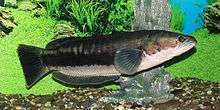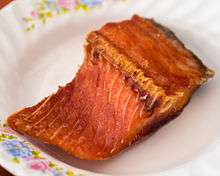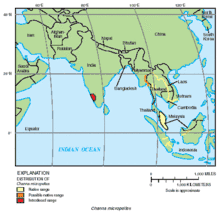Channa micropeltes
Channa micropeltes, giant snakehead, giant mudfish or Indonesian snakehead, is among the largest species in the family Channidae, capable of growing to 1.5 m (4.9 ft) in length and a weight of 20 kg (44 lb).[2] It is native to the fresh waters of Southeast Asia (south Indian populations are now regarded as a separate species, C. diplogramma),[2][3] but has also been introduced elsewhere, where considered invasive. Other names include xal mas (শাল মাছ) in Assamese, red snakehead, redline snakehead, and Ikan Toman (where "ikan" is fish in Malay and Indonesian).
| Channa micropeltes | |
|---|---|
 | |
| Scientific classification | |
| Kingdom: | Animalia |
| Phylum: | Chordata |
| Class: | Actinopterygii |
| Order: | Anabantiformes |
| Family: | Channidae |
| Genus: | Channa |
| Species: | C. micropeltes |
| Binomial name | |
| Channa micropeltes (G. Cuvier, 1831) | |
| Synonyms | |
| |
Biology
The young of the Channa micropeltes are red in color, with orange and black lateral stripes appearing after about two months. As the giant snakehead matures, it loses its stripes and redness, and instead develops a bluish-black and white pattern on its upper body. Juveniles sold in the aquarium fish trade are commonly called "red snakeheads". They can get up to 1.5 m (4.9 ft) long and a weigh 20 kg (44 lb).[2]



The species has the ability to crawl onto land and breathe air, although they are only able to do this in muddy or swampy areas, hence the nickname "mudfish".
Its ability to breathe air using a primitive lung located just behind the gills allows it to survive in stagnant water where oxygen levels are low, by coming to the surface and taking a small gulp of air. It also enables the snakehead to travel short distances on land, although it is unable to hunt while on land, as it cannot support itself at all with its small fins in comparison to its large body.
Use as food

In Malaysia and Singapore, they are known locally as the toman, while in Indonesia they are called gabus or haruan (not to be confused with another species of smaller snakehead known as the common snakehead also called haruan), and are cultured in fish ponds and reservoirs as game fish because they put up a strong fight when hooked. The giant snakehead is also a good fish to eat, and is often served in Chinese restaurants.
In Thailand, this fish is prepared in a variety of ways, especially grilled, being a common food item offered by street vendors. In the village/rural parts of Kerala[India], it has the reputation as a good food fish as it eats only live baits.
In various Asian cultures, eating this fish is believed to help in healing of the body, for example, after surgery or severe cuts and scrapes.
In the aquarium
Channa micropeltes, frequently referred to as the red or redline snakehead in the fish keeping hobby, is a popular fish to be sold in the pet trade. They are commonly sold as juveniles as pets. Some are even sold as feeders to be fed to larger carnivorous fish. They are voracious predators that will chase and eat anything that fits in their mouths. Due to this, they are called "freshwater great whites". However, they can successfully be housed with silver arowanas, clown knife fishes, oscars, and other fish from same size group.
Distribution

Channa micropeltes is found in Southeast Asia, Malay Peninsula and Indonesia .[2] It used to be believed to have an oddly disjunctive distribution, inhabiting both Southeast Asia and southwest India, about 2,500 km (1,600 mi) apart. The Indian population was speculated to be from an early human introduction, prior to the 19th century.[5][6] In 2011 it was established that the southeast Asian and Indian population are separate species, with the latter correctly named C. diplogramma (leaving C. micropeltes for the southeast Asian population).[2][3]
Ebanasar (1995) has also conducted series of experiments on the biology, physiology and culture of this fish. This fish is reported to be highly suitable for cage culture and culture in ponds in combination with tilapia. It is found to be an effective tool in controlling the overpopulation of tilapia and thus checks the stunted growth of tilapia.
As the result of human introductions, Channa micropeltes has been reported already in six US states, including Wisconsin, Maryland, and parts of Virginia.
As an invasive species
In 2004 and 2005, three specimens of Channa micropeltes were caught in Maryland, USA, all believed to have been released pets. In 2003, an example was caught in Rock River, Wisconsin.[7] Biologists were concerned that warmwater effluents could allow the tropical species to survive in the colder climate, but as yet there is no evidence of an established population, with all catches believed to be aquarium releases.[8]
In 2010, one was found dead on the shores of the Saint-Charles River, in Quebec City, Canada. It was obviously an aquarium release.[9]
Hoax
In 2005, a specimen of C. micropeltes was reportedly caught by an angler while fishing for pike on the River Witham in Lincolnshire, England. The claim of this catch is highly peculiar, as it was reportedly caught in late winter, and, being a tropical species, it would not have been able to survive, let alone feed in an English river during winter.[10] However, it was later determined to be a hoax; the fish had actually been found dead in a street.[11][12]
References
- Allen, D. (2012). "Channa micropeltes". IUCN Red List of Threatened Species. 2012: e.T172432A1342060. doi:10.2305/IUCN.UK.2012-1.RLTS.T172432A1342060.en. Retrieved 23 December 2019.
- Froese, Rainer and Pauly, Daniel, eds. (2014). "Channa micropeltes" in FishBase. May 2014 version.
- Benziger A, Philip S, Raghavan R, Anvar Ali PH, Sukumaran M, et al. (2011). Unraveling a 146 Years Old Taxonomic Puzzle: Validation of Malabar Snakehead, Species-Status and Its Relevance for Channid Systematics and Evolution. PLoS ONE 6(6): e21272
- Courtenay, Jr., Walter R. and James D. Williams. Chiana Micropeltes Archived 2006-11-15 at the Wayback Machine USGS Circular 1251: Snakeheads (Pisces, Chinnidae) - A Biological Synopsis and Risk Assessment. U.S. Department of the Interior, U.S. Geological Survey. 2004-04-01. Retrieved 2007-07-15.
- Ebanasar, J. 1995. "Studies on some aspects of the Culture of murrels Channa micropeltes, Channa marulius and Channa striatus." PhD Thesis University of Kerala.
- Ebanasar, J. and V. Jayaprakas. 1995. "Cage culture a conservation strategy for an endangered murrel Channa micropeltes." Proceedings of Seventh Kerala Science Congress.
- Giant snakehead found in Wisconsin waters (News item). U.S. Department of the Interior, U.S. Geological Survey, Non-indigenous Aquatic Species program. 2003-09-19. Retrieved on 2007-07-16.
- Nico, Leo; Fuller, Pam; Neilson, Matt (2 May 2013). "Giant Snakehead factsheet". Nonindigenous Aquatic Species. U.S. Geological Survey. Retrieved 27 August 2017.[]
- http://www.mrnf.gouv.qc.ca/presse/communiques-detail.jsp?id=8207
- Chew, M. K. (2008-02-19). "Attack of the killer fish?". New Scientist. 301. p. 52. doi:10.1126/science.1085274. Retrieved 2008-02-20.
- Clarke, Matt (April 2008). "Snakehead catch 'a hoax'". Practical Fishkeeping.
- Webster, Roy (2008-03-05). "Picture perfect haul delights Harris". Norfolk Eastern Daily Press. Archived from the original on 2008-04-15. Retrieved 2008-04-01.
Further reading
- Ebanasar J. and V.Jayaprakas 1995b. Culture of three species of murrels with mossambique tilapia at three predator-prey densities in earthen ponds. J. Aqua . Trop. 10: 221-229.
- Ebanasar J. and V.Jayaprakas 1996. Food utilization of Channa micropeltes (Channidae: Pisces) fed three diets of animal origin. Indian J. Exp. Biol. 34:1261–1264.
- Ebanasar J. and V. Jayaprakas 2000 Influence of predator size on satiation and gastric evacuation of a predatory fish Channa micropeltes. Indian Journal of Comparative animal Physiology 18 : 44-55
- Ebanasar, J., B.D.Sheeja and R.Narayanan 2001. Nutritive value and Bio-chemical composition of selected freshwater fishes. Journal of Social Medicine 55-57.
- Ebanasar. J and V. Jayaprakas (2003) Growth and food utilization of Juvenile giant murrel Channa marulius and striped murrel Channa striatus fed with diets of animal origin. Symposium on physiological approaches to conserve biodiversity and to tackle environmental health hazards. Indian Society for comparative animal physiology. Tirupati.
- Jayaprakas. V and J.Ebanasar (2003) Enzymes activity in the alimentary canal of malabar snake head Channa micropeltes fed with different diets. Symposium on physiological approaches to conserve biodiversity and to tackle environmental health hazards. Indian Society for comparative animal physiology. Tirupati.
External links
| Wikispecies has information related to Channa micropeltes |
| Wikimedia Commons has media related to Channa micropeltes. |
